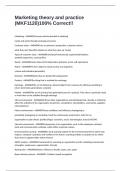Marketing theory and practice
(MKF1120)100% Correct!!
Marketing - ANSWERA human activity directed at satisfying
needs and wants through exchange processes
Customer value - ANSWERFrom a customer's perspective, customer value is
what they 'get' (benefits) relative to what they 'give up' (costs)
Types of customer value - ANSWERFunctional/instrumental, experiential/hedonic,
symbolic/expressive, cost/sacrifice
Needs - ANSWERInnate states of felt deprivation (physical, social, self expression)
Wants - ANSWERThe form taken by needs as they are shaped by
culture and individual personality
Demand - ANSWERWants that are backed by buying power
Product - ANSWERThe thing that is available for exchange
Exchange - ANSWERThe act of obtaining a desired object from someone by offering something in
return (restricted, generalised, complex)
Market - ANSWERThe set of all actual and potential buyers of a product. They share a particular need
or want that can be satisfied through exchange
Micro-environment - ANSWERAll those other organisations and individuals that, directly or indirectly,
affect the activities of the organisation (customers, competitors, shareholders, community, suppliers,
intermediaries)
Macro-environment - ANSWERThose conditions and influences impingeing or
potentially impingeing on marketing. Must be continuously monitored in order for an
organisation to plan ahead. (political/legal, economic, social, technological, natural: PESTN)
Internal environment - ANSWERComponents of an organisation, such as the employees, physical
tools and communication methods, which affect corporate culture.
Environmental scanning - ANSWERAn early warning system for the environmental forces which may
impact a company's products and markets in the future. Scanning enables a company to act rather
than react to opportunities and/or threats.
SWOT analysis - ANSWERA framework for assessing an organisation and its marketing environment
(strengths, weaknesses, opportunities, threats)
Buying roles - ANSWERInitiator, influencer, decider, buyer, user, payer
Buyer decision process - ANSWER1. Problem (need) recognition
, 2. Information search
3. Evaluation of alternatives
4. Purchase
5. Post purchase evaluation
Internal influences - ANSWERPerception, motivation, learning, attitudes, personality, age groups,
lifestyle
Social influences - ANSWERCulture, subculture, social class, group memberships
Situational influences - ANSWERPhysical environment, time
Market research - ANSWERSystematic and objective identification, collection, analysis, dissemination
and use of information that is undertaken to improve decision making and solve problems.
Market research process - ANSWER1. Define problem
2. Develop approach to problem
3. Develop a research design
4. Do fieldwork/collect data
5. Analyse data
6. Prepare report
Competitive intelligence - ANSWERThe systematic collection and analysis of publicly available
information about competitors and developments in the marketing environment
Marketing information system (MkIS) - ANSWERA formalised set of procedures for generating,
analysing, storing, and distributing pertinent information to marketing decision makers on an
ongoing basis
Marketing segmentation - ANSWERThe process by which a market is divided into distinct customer
subsets of people with similar needs and characteristics that lead them to respond in similar ways to
a particular product offering and strategic marketing programme
Mass marketing - ANSWEROne marketing approach for all customers
One-to-one marketing - ANSWERCustomised approach for each customer
Characteristics of segments - ANSWERAdequate size, measurability, accessibility, responsiveness,
compatibility
Steps in segmentation - ANSWER1. Define market
2. Segmentation
3. Targeting
4. Positioning
Segmentation variables - ANSWERDemographic/social, psychographic, behavioural, benefits sought




